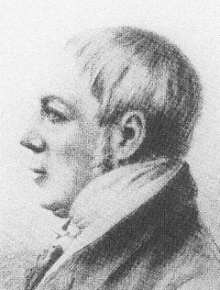William Hedley
| William Hedley | |
|---|---|
 |
|
| Born |
13 July 1779 Newburn, England |
| Died | 9 January 1843 (aged 63) |
| Nationality | British |
William Hedley (13 July 1779 – 9 January 1843) was born in Newburn, near Newcastle upon Tyne. He was one of the leading industrial engineers of the early 19th century, and was instrumental in several major innovations in early railway development. While working as a 'viewer' or manager at Wylam Colliery near Newcastle upon Tyne, he built the first practical steam locomotive which relied simply on the adhesion of iron wheels on iron rails.
Before Hedley's time, such locomotives were far too heavy for the track that was then available. While most lines used cable haulage with stationary engines, various other schemes had been tried. William Chapman at the Butterley Company in 1812, attempted to use a steam engine which hauled itself along a cable, while, at the same company, Brunton had produced the even less successful "mechanical traveller", or Steam Horse.
However, in 1812, Matthew Murray and John Blenkinsop had produced the first twin cylinder steam locomotive, Salamanca, for Middleton Colliery railway near Leeds, using a pinion engaging with teeth along the iron edge rails track (first rack railway). This had been the first steam locomotive railway to work successfully, but the system was complex and expensive.
Hedley felt that if the pairs of wheels were connected, as with Richard Trevithick's engines, if one pair began to slip, it would be counteracted by the other. The mine owner, Christopher Blackett had just replaced the wooden waggonway with iron flanged 'L' section plate rails. Hedley first constructed a test carriage operated by manpower, to test the adhesion under various loads. He then used it as the chassis for a locomotive constructed to Trevithick's pattern with a single cylinder and a simple straight through fire tube to the boiler. This engine was not satisfactory. Its motion was erratic, because of the single cylinder, and it produced insufficient steam.
...
Wikipedia
